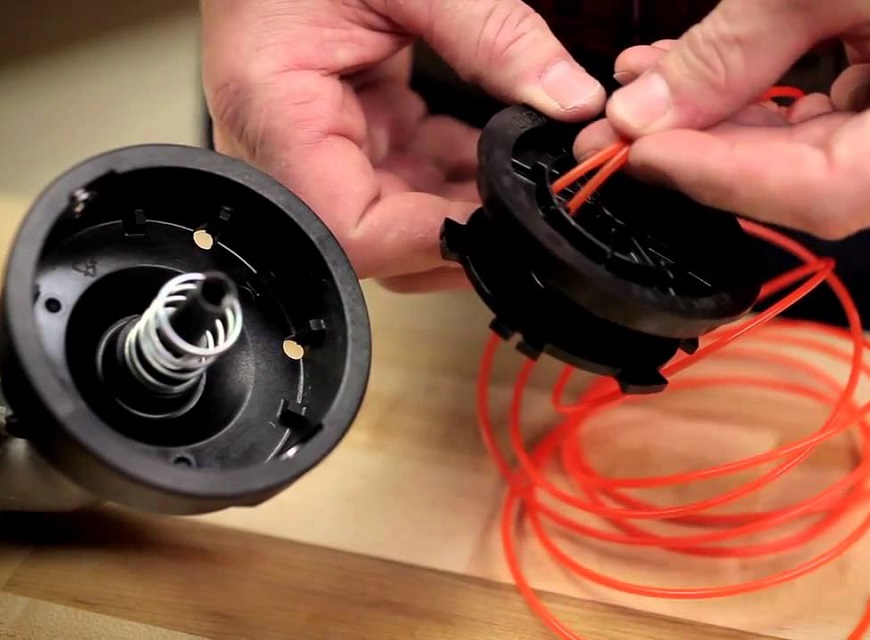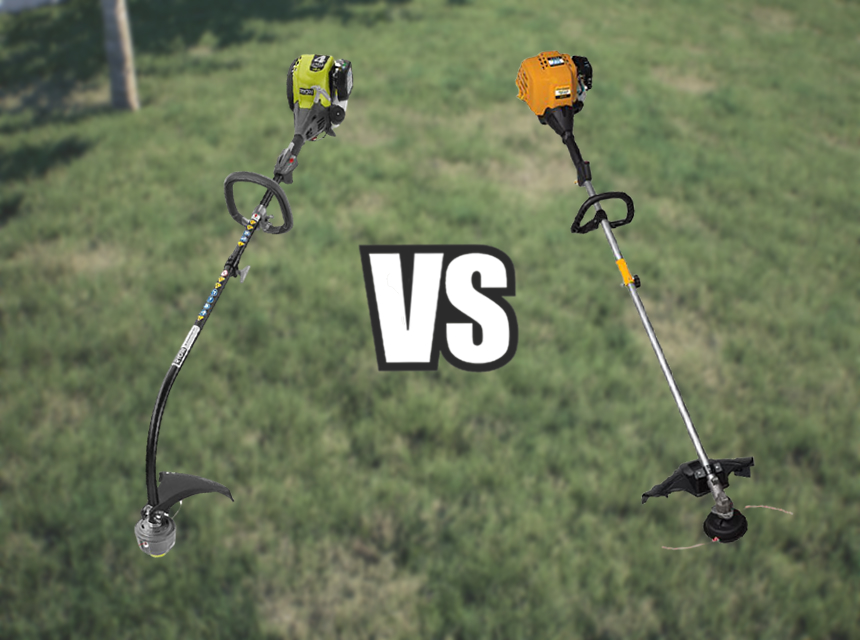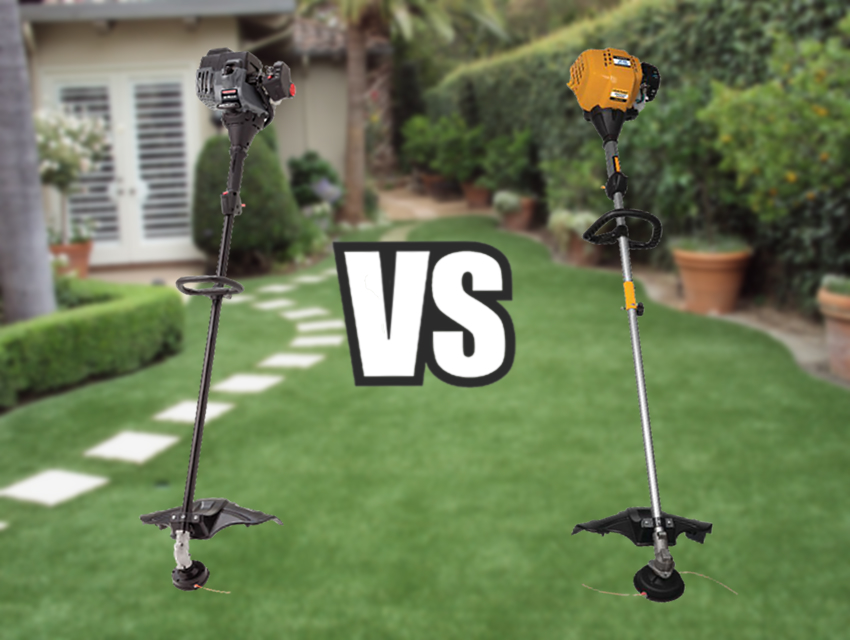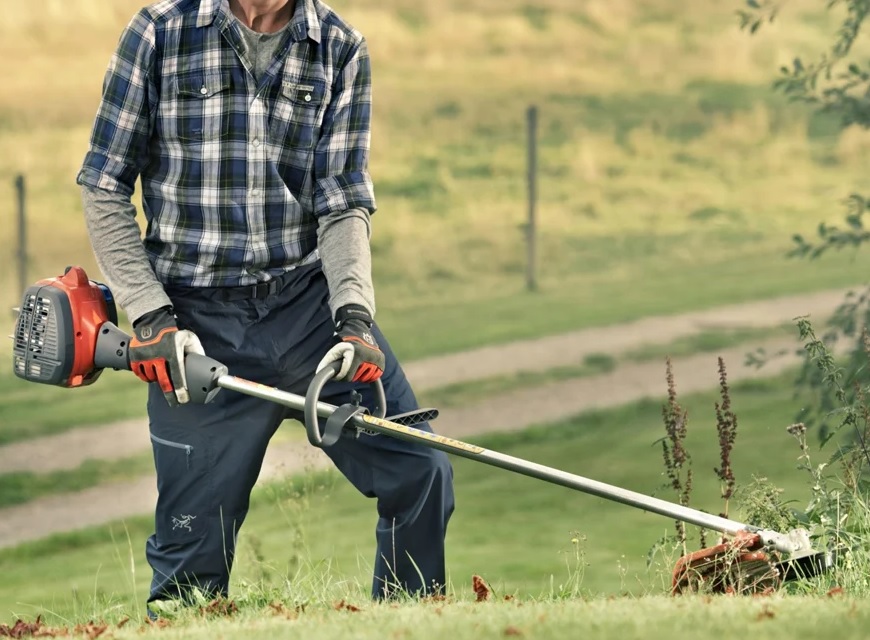
With lawn maintenance, equipment is everything. For this reason, homeowners can spend small fortunes getting the lawnmower of their dreams. However, the lawnmower isn’t the only essential piece of equipment. Weed eaters are also needed, especially when tidying up the yard after a mow.
There are variations in weed eaters where gas and electric models are the two common types. This brings up questions of superiority where buyers want to know which option wins in an electric vs. gas weed eater debate. Notably, the answer will likely inform the machine they end up purchasing. As such, our team delves into the characteristics of both weed eater types in hopes of giving you an answer.
There are so many ways to refer to a weed eater that the names can get confusing. After all, the terms: brush cutter, whippersnapper, strimmer, string trimmer, line trimmer, and weed whip all refer to the same thing. Depending on your locale, any one of these could be the preferred slang.
That said, it has already been implied in the introduction that the weed eater is a lawn maintenance tool. It is capable of cutting grass just like the lawnmower. However, the mechanism used to trim the blades of grass is entirely different as it is usually a wire or flexible plastic line instead of a blade.
The design is also quite different from that of the lawnmower. This machine is meant to be handheld, and for this reason, it consists of two major parts: the handle and the cutting head. These two are attached by a relatively long but thin shaft that makes it easier to use the device without having to bend and strain your back.
Depending on the model, the intended market for the device, and the intended use, the shaft in question could either be straight or curved. The former is great for plain lawns where you just want to trim the grass from point A to point B. As for the latter, it might be better for lawns with more obstacles, e.g., sculptures, fences, flower beds, and more. The design allows users to work around these obstacles without damaging them.
According to most reviewers, the Echo GT-225 is a popular option for users with many obstacles in their lawns. Since it’s a gas strimmer, it ranks high in terms of power and, consequently, shouldn’t have any problems with weeds.
The handle part of the string trimmer always has an on/off mechanism and an accelerator/clutch. Depending on the type, it may also come with additional features. As for the cutter section of the machine, the components will depend on the model. However, common aspects include a feed head and gear case, which may house the motor.
There are other parts, e.g., a line limiter blade, a debris shield, an edge guide, and more in a select few machines. Notably, the line or wire is not a part of the device. Instead, it is an extra purchase, although the first one you use may be provided with your brush cutter garden tool. It is also the component that does the cutting.
The lines used are relatively tough and durable, and when the rotating wheel in the cutter head spins, these wires and cables spin as well. Consequently, there is centrifugal force created that makes the line stiffen up. Also, this is the motion that cuts the grass just like the spinning blade on a lawnmower.
That said, wires and plastic lines aren’t as tough as blades, meaning they occasionally snap when put to work. It is for this reason that the feed head is included. You put a long plastic line in this section, and whenever the cutting line snaps, you can feed the extra line directly into the cutting area without having to stop your trimming session for long.
Also, depending on the line’s thickness, you can use it to target grass or woody plants and weeds. Thicker is preferred for the woody plants and weeds as they are harder to cut through. The significant differences in these machines come up in the positioning of the engine and the power produced. However, they all have the same basic working structure.
We are first going to start with electric weed eaters in our comparison of the line trimmer types. The handles on these devices are simple and typically only host the components we mentioned before, namely the accelerator and an on/off button. Also, they should have an electrical wire connection near the handle.
Select models may have a strap if the entire device is relatively heavy to offset some of the strain from the user’s hands. Notably, the wire should have a male end that plugs into traditional household sockets. As for the cutting end of the machine, that is where you find the motor that rotates the line or wire.
Once you have connected the electrical wire to a socket and pressed the on/off button, the machine can start. However, this doesn’t mean that the device can start cutting the grass. Instead, it means that it is now in standby mode waiting for further instructions.
However, when you press the clutch, the cutting head and line should start rotating, leading to the centrifugal force that we mentioned before. You can raise or lower the speed by working the clutch as you see fit. We recommend higher speeds when dealing with stubborn weeds and woody plants.
That said, there is a limit to how much the electric weed eater can do. This is because it maxes out at 1200 watts which is a fraction of the power produced by gas-powered line trimmers. Another potential worry for buyers is how far the machine can be taken from the house.
Notably, extension cords are available in all sizes, and you can get any one of them if it suits the size of your yard. Bear in mind that the longer the cord, the more expensive it is likely to be.
Another thing you have to be careful of is the capability of the cord. Your electric machine might be less powerful than a gas weed eater, but it still needs a lot of power compared to other household appliances. It is thus better to get heavy-gauge extension cords which are more expensive since they can handle the extra electric load needed by the machine.
As a side note, in this gas vs. electric weed wacker debate, most homeowners tend to pick the electric option since it’s better for the yard cleanup jobs they are more likely to encounter. However, professionals and those with larger yards tend to opt for gas weed eaters.
With previous electric weed eater models, you had to hit the cutting end of the machine on the ground to activate the release mechanism for the trim line. On the other hand, newer models don’t require as much work since they come with auto-feed technology. Consequently, they have a trigger/ button on the handle that adjusts the line length when pressed.
Remember that these are power tools, and as such, they can injure you. Consequently, care during use is highly recommended. Some will come with safety features such as a safety switch. As such, you would need to press two buttons at the same time for the device to work. This makes it harder to cut yourself when you press the clutch or accelerator.
However, there are other measures you can take, including wearing protective gear on your eyes and even your legs. Aside from that, try not to bring the machine or electrical cord into contact with water. After all, they are electric appliances.
Some of these safety measures should apply whether you’re using the electric or the gas version of the device. Notably, the Toro 51480 seems to have garnered lots of praise among corded weed eater lovers for features like the adjustable handle assist and telescoping handle.
There are a couple of negative and positive aspects to these electric brush cutters that we delve into in this section. Starting the pros list is the fact that electric variations of the machine are quieter. This is, of course, in comparison with gas-powered alternatives. The fact that they use an electric motor rather than a combustion engine does help make them quieter.
Another pro that results from not having a combustion engine is the lack of emissions. This makes them better suited for our environment as they don’t contribute to greenhouse gas production and global warming.
Next is that these machines start easily. Connect it to a power source, push a button, and then get started. Electric options also won’t be problematic for women, children, and the elderly to use. They are lightweight since they don’t have fuel tanks. Another thing is that due to less power, the strength needed to keep them in line isn’t much.
Notably, less power is a double-edged sword in that it can also be a con. This is one reason why they aren’t popular with large lawns. Also, they may struggle more with woody bushes as compared to the gas alternatives.
The second con is that their range is limited. This is because the cords included are relatively short. Also, not many people are willing to buy extra long extension cords to keep up with their lawn needs. The last disadvantage is that the cords themselves can make it more challenging to navigate the lawn when trimming or edging your grass.
Next, we look deeper into gas weed eaters. The variations you encounter will vary where power produced, type of engine, fuel used, and tank size are concerned. The term gas weed eaters implies that they all use gasoline as the primary source of fuel. This is true; however, you may note a slight variation between four-stroke and two-stroke engines.
Four-stroke engines Trusted Source Four-stroke engine - Wikipedia A four-stroke (also four-cycle) engine is an internal combustion (IC) engine in which the piston completes four separate strokes while turning the crankshaft. A stroke refers to the full travel of the piston along the cylinder, in either direction. en.wikipedia.org are standard in top-of-the-line, highly-priced gas weed eaters. They also don’t need any other fuel added to their tanks to work except for gasoline. This is in contrast to the lower-priced, two-stroke engines. For this variation, you’ll need to mix gasoline and oil in the proper ratio for them to work. Failure in managing the ratio can lead to a malfunctioning engine that will likely not last long.
Nevertheless, it seems that there is oil made explicitly for two-stroke Trusted Source Two-stroke engine - Wikipedia A two-stroke (or two-stroke cycle) engine is a type of internal combustion engine that completes a power cycle with two strokes (up and down movements) of the piston during one power cycle, this power cycle being completed in one revolution of the crankshaft. A four-stroke engine requires four strokes of the piston to complete a power cycle during two crankshaft revolutions. In a two-stroke engine, the end of the combustion stroke and the beginning of the compression stroke happen simultaneously, with the intake and exhaust (or scavenging) functions occurring at the same time. en.wikipedia.org gas weed eaters. It should come in a 2.6-ounce bottle when purchased. This makes it easier to maintain the ratio as every 2.6-ounce bottle of oil should be mixed with one gallon of gasoline.
It’s dangerous to mix the two fuel types in your weed whip’s tank, and you should instead find a separate container for the process. This allows for a thorough mix to keep the engine safe.
Starting a gas weed eater typically involves yanking a cord. More modern trimmers tend to require just one pull of the cord to start.
The machine is relatively loud when starting and when in use. Nonetheless, it goes into idle mode if you let it sit for a while where the cutting head doesn’t rotate. However, the accelerator is there for you if you want to get back to trimming your lawn.
Starting the engine is different from electric options since there is a spark plug involved, ignition, and the burning of fuel in the engine. It is basically like most car engines in this regard in that it will use up the fuel to keep the engine running.
The engine’s crankshaft, accelerator, driveshaft, and cutting head are all connected. As such, the engine’s power will ultimately be transferred to the cutting head to rotate the cutting line. Like the electric option, it will build upon the centrifugal force, leading to a stiff line that can cut through grass and weeds like butter.
You can refill the gas tank as often as you need to ensure you finish up your trimming project. This is regardless of the size of your lawn.
As for the pros and cons, these gas weed eaters have a few as well. The reason why professionals like gas weed eaters so much is because of their superiority in power. You don’t have to run over the same patch of weeds over and over again to get the right results.
In the right hands, gas-powered weed eaters can last for years and years. The reason why some of them don’t last is that their maintenance is lackluster. As such, the blame for this falls squarely on the owner.
Another positive is they aren’t limited in movement. They don’t have cords that restrict you to a particular working radius. Additionally, you don’t have electrical cords that you have to move or work around every few minutes. This also makes them ideal for maneuvering around obstacles in your yard.
At the top of the list for gas weed eater cons, you have noise. The engines in these machines may make so much noise that you’ll be forced to wear protective ear coverings. They also need more attention and maintenance than other machine variations.
We already alluded to this when we mentioned mixing the proper fuel ratio. Furthermore, leaving fuel in the tank when not using the machine could lead to undesirable effects such as engine damage. Of course, this also means that maintenance costs are relatively high.
They burn fuel, and since gasoline doesn’t grow on grass, you’ll have to buy it time and time again. This translates to a high cost of use, and lastly, there will be emissions from the machine. As such, they do leave a large carbon footprint when used.
The gas vs. electric string trimmer discussion is also not done until you’ve accounted for the cordless weed eaters category. Notably, these machines could still qualify as electric weed eaters. However, there are slight differences present when compared to traditional electric weed eaters that necessitate the distinction in the name.
For one, the term cordless is descriptive of their nature. As such, they’re not delivered with the same electrical cords you find in regular electric line trimmers. Consequently, you won’t be connecting them with a socket or an extension cord to provide them with power.
Instead, you will receive a battery and a charger. The latter will charge up the battery, and once it’s full, you’ll remove it and attach it to the strimmer.
Depending on the model, brand, and the effort the manufacturer put into creating the battery and the charger, it typically takes at least three hours to charge the battery fully. However, depleting the battery is much quicker, and you’ll need a recharge every 30 to 60 minutes.
Also, there is no rule against buying extra batteries, but they can get expensive. Nevertheless, you’ll probably never see people with more extensive lawns getting these types of weed eaters. If you’re well versed in electrical equipment, you’ll notice that except for the battery being the source of power instead of a socket, these cordless and electrical weed eaters are practically identical.
Cordless models are not exactly known for their power and are in the same boat as their corded counterparts. However, recently manufacturers have started using brushless motors, giving them a power edge over previous models. Also, not having to deal with cables and wires is a definite positive.
Notably, cordless options are another excellent buy for homeowners with small lawns. They are quiet in operation, relatively lightweight, don’t need much attention, and can reach virtually any patch of grass or weeds you set your sights on. This is regardless of whether there are obstacles in the way or not. Their flaws are the relative lack of power and the short battery life.
According to most reviews, the Worx WG163 GT 3.0 qualifies as a top-tier cordless weed eater. The features such as instant line feed, the tilting head, spacer guard, and the two batteries included are a few reasons why previous buyers seem to recommend this model for other would-be cordless weed whip buyers.
Seemingly, none is better than the other when you look at both types objectively. However, if you look through your needs and prejudices, you might come to a suitable conclusion. For example, if you know you have tough weeds in your large lawn, it makes more sense to get the more powerful gas weed eaters.
Refueling and getting back to work till you finish trimming will be an easy matter if you have the correct know-how. Conversely, a cord can restrict you from reaching the ends of your lawn, and if the yard is large enough, battery-powered models will struggle as well.
For homes with small yards and few obstacles in the lawn, the electric line trimmers may be better. They can get the job done quickly, are emission-free and barely need maintenance. Conversely, for yards that look like a fun obstacle course or maze, the cordless options may be better overall.
It seems any of the above models could be the better option depending on the situation. Consequently, you need to assess your situation then make an informed decision using the pros and cons lists we’ve given above.
If you need any refreshers on; how these machines are different, which ones work better for your particular situation, and the pros and cons of each, this write-up is here for you. You can bookmark it, and when you decide to make the purchase, you can find valuable data on the electric vs. gas weed eater debate right here. You can also reevaluate your needs whenever you move house and decide if you need a different machine or not.





